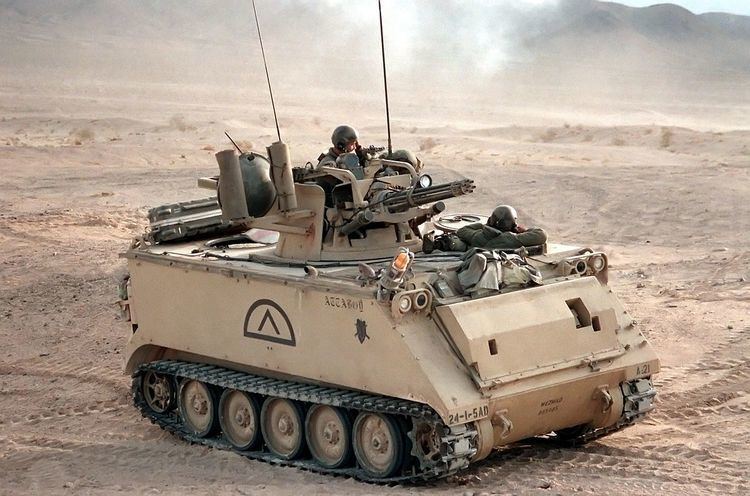In service 1968–present | ||
 | ||
Type Self-propelled anti-aircraft gun Used by United States of America, NATO Wars Vietnam WarWestern Sahara War1982 Lebanon WarInvasion of PanamaPersian Gulf War Weight 27,542 pounds (12,493 kg) (combat weight) | ||
The M163 Vulcan Air Defense System (VADS) is a self-propelled anti-aircraft gun (SPAAG) that was used by the United States Army. The M168 gun is a variant of the General Dynamics 20 mm M61 Vulcan rotary cannon, the standard cannon in most U.S. combat aircraft since the 1960s, mounted on either an armored vehicle or a trailer.
Contents
Technical description
The weapon is mounted on a modified M113 vehicle (the M741 carrier). The system was designed to complement the M48 Chaparral missile system. The M163 uses a small, range-only radar, the AN/VPS-2, and an M61 optical lead-calculating sight. The system is suitable for night operations with the use of AN/PVS series night vision sights that can be mounted to the right side of the primary sight.
The gun fires at 3,000 rounds per minute in short bursts of 10, 30, 60, or 100 rounds, or it can fire in continuous fire mode at a rate of 1,000 rounds per minute. A linkless feed system is used.
Performance
From the beginning, the main drawback of the M163 was its small caliber and lightweight shells, which limited its effective range. Early M50 series ammunition exacerbated the situation, but the M163 was still comparable to the contemporary Soviet ZSU-23-4; although the Russian ZSU fired a larger shell (23 mm rather than 20 mm) and a higher rate of fire, the M163 had a higher muzzle velocity providing a flatter trajectory, shorter time of flight and thus better accuracy.
Unlike the ZSU the M163 has no search radar, and has limited engagement capability against aircraft at night. The M163 gunner is exposed in the open turret, whereas in the ZSU-23-4 the gunner is in a fully enclosed armored turret; this gives the M163 gunner much better situational awareness and field of view at the cost of losing protection against rifle-caliber weapons and shell fragments. This is important, especially since the M163 has no search radar.
In US and Israeli service the VADS has rarely been needed in its intended purpose of providing defense against aerial threats—consequently the Vulcan gun system was in use throughout the late 1980s and early 1990s primarily as a ground support weapon. For example, VADS guns were used to support American ground assault troops in Panama in 1989 during Operation Just Cause. One Vulcan of B Battery, 2/62 ADA even sank a PDF Vosper PT boat. The last combat action the VADS participated in was Operation Desert Storm.
Upgrades and replacement
In order to provide effective battlefield air defense against helicopters equipped with anti-tank missiles that could be fired accurately from ranges of several kilometers, the VADS was slated to be replaced by the M247 Sergeant York DIVADS (Divisional Air Defense System), but that system was canceled due to cost overruns, technical problems and generally poor performance.
In 1984 the improved PIVADS (Product-Improved VADS) system was introduced, providing improvements in the ease of use and accuracy of fire, but the limitations of the 20x102mm caliber remained. Also, the radar remained a range-only device. In the late 1980s modifications to the Vulcan through the addition of an interior and an exterior rack designed to carry Stinger missiles for dismounted firing were added in order to extend the life cycle of the system.
Eventually the M48 and M163 were both replaced in US service by the M1097 Avenger and the M6 Linebacker, a M2 Bradley with FIM-92 Stinger missiles instead of the standard TOW anti-tank missiles: the Stinger missile providing the necessary range to deal with helicopters with anti-tank missiles far out-ranging the 20 mm gun, as well as considerably extending the reach against fixed-wing targets. The final US Army VADS equipped unit at Fort Riley Kansas completed turn in of its Vulcans in 1994.
Ammunition
A wide variety of ammunition has been designed for the 20×102 caliber of the M168 six-barrel Gatling gun. Main types of combat rounds are listed in the table below; for comparison purposes the table includes also the PGU-28 round used in M61 Vulcan aircraft cannon and the Mk149 naval anti-missile APDS rounds, although these are not normally used in land-based air defense guns.
Specifications
Variants
History of service
In the Israeli Air Defense Command the "Hovet" (the Israeli designation to the M163 VADS) scored 3 shot-downs, including the first shot-down of a jet warplane (a Syrian MiG-21 fighter jet) by the M163 VADS, during Operation Peace for Galilee in 1982. The Israel Defense Forces used the M163 Hovet also for fire support during urban warfare in Operation Peace for Galilee (1982) and Operation Defensive Shield (2002).
